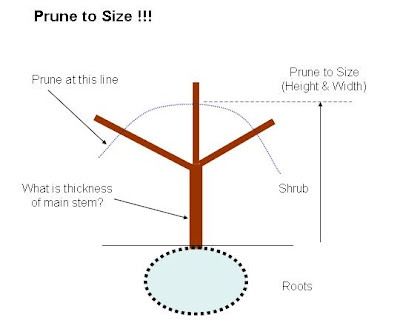I thought this could be interesting topic to discuss.
I must admit there are times I am quite undecided how much to prune, especially when my roses defoliated from infection or pest infestation or continous pouring rain.
Is it necessary to prune down to the main stems, or shall I just dead head the flower buds, or shall I just prune lightly.
After making some observations, I have found the best gauge to decide how much to prune is by estimating the 'strength' of plant roots beneath the soil.
The function of plant roots apart from providing support and taking in nutrients to for plant, it also stores food manufactured by the plant.
The food manufactured through photosynthesis is stored in both plant roots and stems. As more food is stored in roots and stems, they become thicker over time. Therefore when the stems are pruned, more food is channeled to the plant roots.
As more food is stored in the plant roots, it increases the surface area of roots thus increases its ability to take in more nutrients.
On the contrary, when the stems are not regularly pruned, more food is channeled to plant stems (for thickening of stem and new bud growth) than it is to the roots. Therefore when the rose shrub grows fuller it raises its minimum plant uptake requirements. Eventually the lower leaves (near to main stem) will begin to turn yellow, when the current nutrients uptake fall below the plant uptake requirements.
Pruning is likened to provide a balancing of uptake and consumption of nutrients. The rule of thumb is that the uptake of nutrients must always exceed the consumption.

Therefore by pruning, we actually reduce the minimum nutrients consummption of the rose plant, so that there is always enough nutrients uptake for consumption.
One of the clear signs that consumption exceeds uptake is when the lower leaves turn yellow or the leaves near to new bud growth. It is because it draws extra supplies of nitrogen fron the leaves to feed for new growth.
I have found the best gauge to decide how much to prune is by estimating the 'strength' of plant roots beneath the soil
One of the ways you can estimate the strength of your plant roots is by measuring the diameter size of the main stem. The thicker/bigger the main stem is, the stronger the roots. However this way of measuring has an exception, that is if this rose plant was recently propogated from cuttings, the roots may not be as established.
How do I determine the shrub size that can have the right balance of nutrients uptake and consumption?
For example, a rose that has potential to grow up to 1 metre in height and main stem up to 3 cm diameter. We can work out the height to prune down by working the ratio of current stem diameter over the fully grown one.
For example, the current stem diameter is measured at 1cm. That means the correct height should be
1cm x 100cm / 3cm = 33.33cm should be the ideal height/size.
Therefore prune about 30% (10cm) of the 33.33cm to create room for growth to reach ideal height/size.
As you get the hang of it, you will know how much to prune at the mid-height of the plant. Generally the rule of thumb is to remove thin, small and unhealthy stems at the mid-height of plant, to create more room for growth. The same principle applies.
I must be willing to give up what I am in order to become what I will be
Einstein
If you prune your rose shrub to lower than ideal height/size, it will ensure many stronger, fuller and healthy bush growth.
***






hello i want ask you.how you prune your plant .are u prune leaf too, or just prune stem only?
ReplyDelete